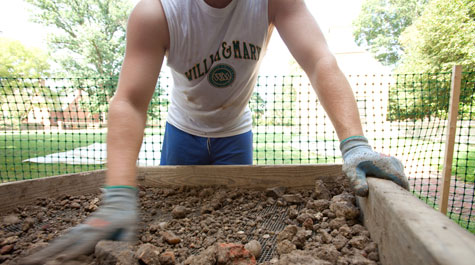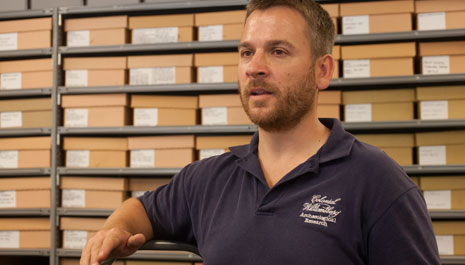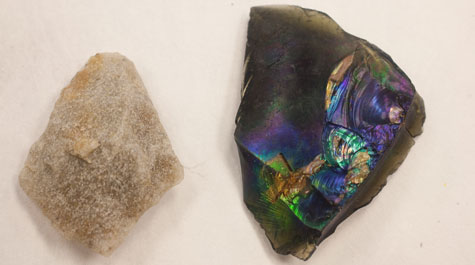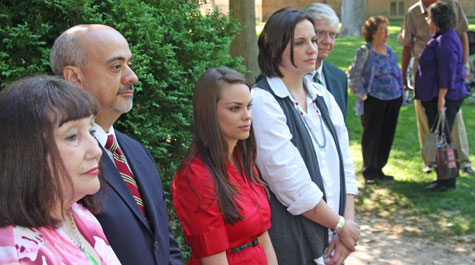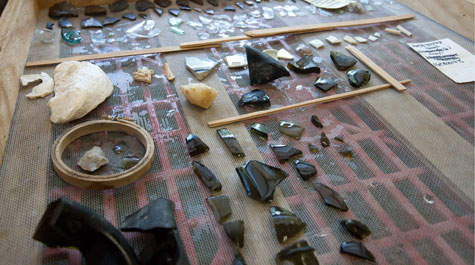Dig sheds light on College's early history
An archeological dig this summer at the College of William & Mary’s Brafferton building uncovered artifacts experts believe point to the school’s early history. Students and staff participating in two five–week field schools located a quartzite bi-face (perhaps a scraping tool or projectile point), pieces of knapped or worked glass, evidence of an early brick sump and posthole evidence of several fence lines dating to the College’s early history.
“Probably the most important thing that we’ve found so far is the knapped glass,” said Mark Kostro, Colonial Williamsburg Foundation staff archeologist, a doctoral candidate in anthropology at the College and director of the field school. The knapped glass pieces are a form of Native American recycling, Kostro says. Pieces of broken bottles are among the most Colonial-era artifacts found, he added, and the shards were a readily available source of raw material for toolmaking.
“They’re pieces of glass that have been fashioned into some kind of tool – a cutting tool, a projectile point or a scraper,” he explained. “They used the same manufacturing process that Native Americans used for making stone tools for millennia. All they’re doing is changing materials.”
{{youtube:medium:center|85dcJg1-GcE,}}
The Brafferton was built in 1723 with funds from the estate of Robert Boyle, a famous English scientist, and was designed to house the College’s Indian School. By the end of the school in the 18th century, Native American boys were being educated in Christianity and the basics of reading and writing. Today, it houses the offices and staff of the president and provost of the university and is steps away from the College’s historic Wren Building and the President’s House. The three buildings make up W&M’s colonial campus.
The dig is a collaboration between Colonial Williamsburg, the anthropology department at the College, and descendants of the Indian boys who resided there.
“The Brafferton represents a complicated and important phase in the history of American Indians at the College,” said Martin Gallivan, professor of anthropology and specialist in the archaeology of Native Americans in Virginia. “It is gratifying to see the current project recovering evidence of this history and to see contemporary Native Americans contribute to the project as archaeologists and advisors.”
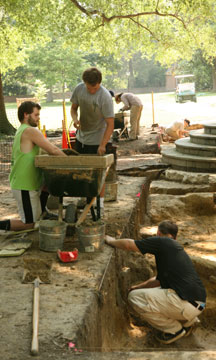 At the time of the American Revolution, the College lost the income from the Boyle estate, and the Indian School was discontinued. The enrollment numbers have been lost over time. As historical records are scarce, archaeology has emerged as one of the best connections to the life of Native Americans in the early days of Virginia.
At the time of the American Revolution, the College lost the income from the Boyle estate, and the Indian School was discontinued. The enrollment numbers have been lost over time. As historical records are scarce, archaeology has emerged as one of the best connections to the life of Native Americans in the early days of Virginia.
Ashley Atkins ‘09, a doctoral student in anthropology at the College and a Pamunkey Indian, participated in the field school along with her cousin, Jeff Brown – a field archaeologist with Colonial Williamsburg. Touching the past of her elders drew her to the project, Ashley noted.
“What drew me to the project here at the Brafferton was that Pamunkey people, as boys, went to this school in the 18th century.”
The brick sump appears to date to c. 1800, Kostro noted. Designed to drain water from the Brafferton’s basement, he said the feature appeared to have been abandoned in the late 1700s or early 1800s. Subsequently the sump was filled-in with household debris. When archeologist uncovered it this summer, they found hundreds of artifacts dating to the late 18th century including numerous animal bones and oyster shells, several late 18th century Creamware dinner plates, a Black Basalt tea service (tea pot and sugar bowl), and three cannon balls.
“The artifacts found in the sump speak to the use of the Indian schoolroom on the first floor as a college dining room in the late 18th and early 19th centuries, years after the Indian boys were gone,” said Louise Kale, director of William & Mary’s Historic Campus.
While the Creamware and tea service provide a glimpse of life inside the Brafferton, evidence of a series of postholes running east off the northeast corner of the building provide archeologists with a look at how fence lines doted the landscape. Evidence of as many as four separate 18th century fence lines was found, one of which is depicted on the 1782 Frenchman’s Map of Williamsburg.
“More specifically, the four fences were actually different generations of the same fence that enclosed the Wren Yard in the 18th century, with the earliest fence actually pre-dating the Brafferton’s construction,” Kostro said.
Planned construction at the Brafferton – overdue upgrades to heating, cooling and water systems – has provided this opportunity for archeologists to look into the ground around the building’s foundation, an area not previously archeologically surveyed.
To date, a total of $2.25 million in gifts and pledges has been secured for the $4.5 million Brafferton project, leaving $2.25 million still to be raised. Major gifts and grants include a $1 million commitment from the Lettie Pate Evans Foundation; a $300,000 challenge grant from the Mary Morton Parsons Foundation, to be matched with $900,000; and more than $950,000 from individuals, including many members of William & Mary’s Class of 1961 who donated to the project in honor of their 50th Reunion. The College is continuing to raise funds to keep the project on schedule. Members of the Class of 1962 will also take on the Brafferton renewal and preservation as part of a special fundraising project for their 50th Reunion class gift this year.
The findings at the Brafferton join a separate but nearby archaeological dig on the College’s historic campus that researchers say will tell them more about William & Mary’s early history. Researchers at William & Mary’s Center for Archaeological Research announced over the summer the discovery of portions of an 18th century brick foundation from a building not previously known to exist on campus. College archaeologists say the partially unearthed foundation looks to be the remains of “a fairly massive outbuilding,” a structure that was almost certainly associated with slaves who worked at William & Mary in the early 18th century. The foundation runs 20 feet east-west and more than 16 feet north-south.
The archeologists said the finds make them more hopeful and curious about what still may be in the ground.
“It’s striking how little historical archaeology has been conducted on American Indian sites in Virginia,” Gallivan said. “The Brafferton project is a prime example of several recent William & Mary projects shedding light on the post-1607 native experience in the Chesapeake.”
Even though Ashley Atkins’ role in the field school has ended, her involvement in the Brafferton Project will continue. She is also a founding member of The Brafferton Legacy Group – an all Native advisory committee drawn from four Federal and State recognized tribes whose communities have historical links to the 18th century School. The Brafferton Legacy group is coordinated by the William & Mary Department of Anthropology and the American Indian Initiative at the Colonial Williamsburg Foundation and will serve in an advisory capacity throughout the project. Other members of the group include, Paige Archer ’78 (Meherrin), Annette Saunooke ’05 (Eastern Band of Cherokee) and Reginald Stewart ’86 (Chickahominy).
For more information about the project, visit the project's web site.
Joe McClain, director of research communications, also contributed to this story.
 Skip to main content
Skip to main content

